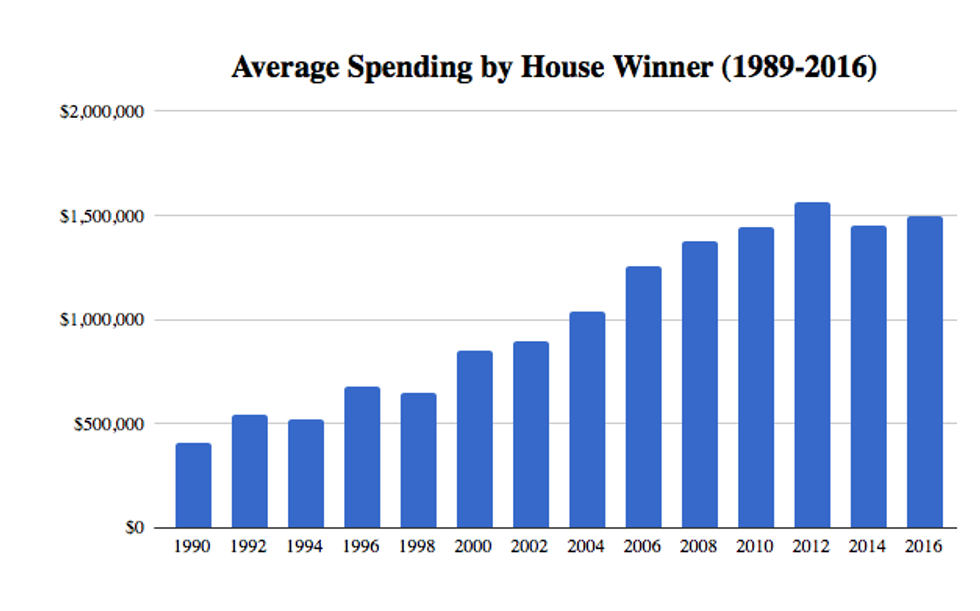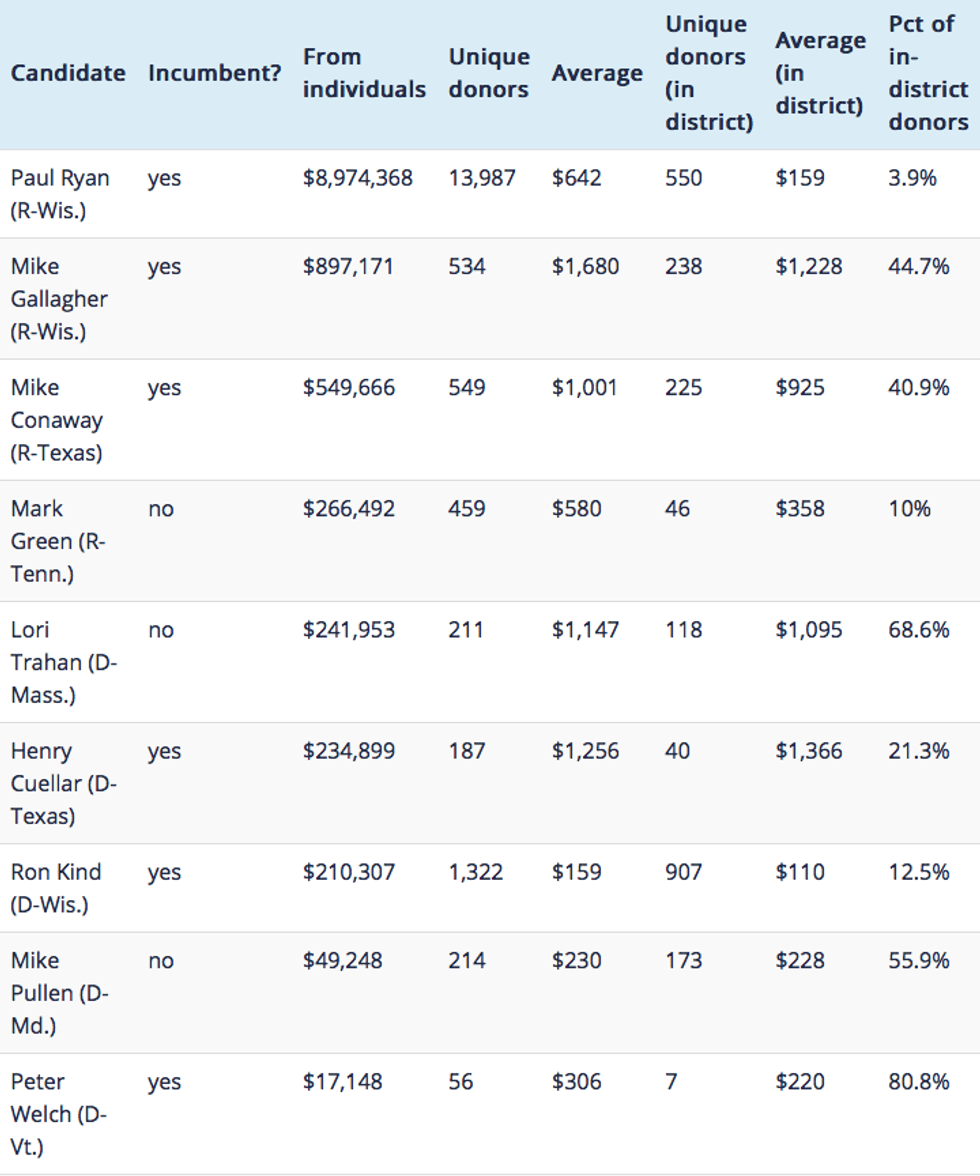
"Raising huge sums of money not only gives your campaign resources but is crucial to gaining recognition as a viable candidate by the main parties." (Photo: DonkeyHotey/flickr/cc)
Grassroots Candidates Tout Small Average Contributions
At a time when elections are increasingly dominated by big money, touting that your average donor gives only $44 is meant to signal to voters that your campaign represents regular people.
Big fundraising totals are a strong indicator of the viability of candidates running for Congress (see below), but in this year's midterm elections, insurgent grassroots candidates' campaign strategy involves flaunting a smaller number: average contribution.

One such candidate is California Democrat Andrew Janz. Earlier this month, he tweeted about his average contribution of $44 and how it compared to incumbent Republican Devin Nunes' big donor fundraising. His campaign told OpenSecrets that since the start of 2018, his total fundraising has grown to roughly $893,000 from just over 21,000 individual donations and that his average has dropped to $42.68.
"I'm running for Congress to represent the people," Janz said. "Big corporations already have enough advocates in Washington. I've focused my fundraising
California Democrat Andrew Janz, second from the left. (Photo via Twitter)
on individual donations because that's who I will be fighting for in Washington."
Money doesn't buy votes, but it helps. In the 2014 congressional midterm elections, the better-funded candidate won 91 percent of the time. In addition, the reelection ratesfor incumbents that year was 95 percent for the House and 82 percent for the Senate.
However, in the same vein as the 2016 primary campaigns of Vermont Senator Bernie Sanders and to an extent President Donald Trump, upstart candidates are counting on a broader base of working class voters making small donations to help them defeat their deep-pocketed opponents.
Because information about donors who give $200 or less is not required to be disclosed on FEC reports, campaigns can keep private the number of unique donors and the geographic distribution of their small donors. Without this information, it is difficult to determine the effectiveness of the small donor strategy.
A few candidates, however, choose to itemize all of their donations regardless of amount, and consequently, we are able to deduce their average donation per contributor (see below).
In order to put the concept of an average donation in context, we assembled data on nine House candidates with less than $100 in unitemized donations in the 2018 cycle into a table that also shows the number of their in-district contributors and their average contribution size. The set of candidates contains a diverse sampling of party, incumbency status and fundraising level, and are listed in no particular order.
For example, in the 2018 cycle, House Speaker Paul Ryan itemized 24,627 contributions in his FEC filings from 13,987 unique donors for a total of $8,974,368. When his total is divided by the number of unique donors, it gives him an average donation of $642. Moreover, 550 of his donors (3.9 percent) were voters in his district and their average contribution was $159. It is clear from the sampling that Ryan's large percentage of out-of-district donors is most likely due to his prominence as a national congressional leader.
House candidates who itemize all individual donations, 2018 cycle

*Table only includes candidates with less than $100 in unitemized donations and who raised at least $15,000 in 2017
Of all the candidates examined, Rep. Ron Kind (D-Wis.) had the largest number of potential voters in his district supporting him with 907. He also had the smallest average donation both within his district and altogether.
Mark Green (R-Tenn.) is a state senator running for a Republican-held House seat to be left empty by now U.S. Senate candidate Marsha Blackburn. Among the Republicans sampled, Green had the smallest average donation overall and the second smallest percentage of in-district donors next to Ryan.
So what's the big deal about a small average contribution?
At a time when elections are increasingly dominated by big money, touting that your average donor gives only $44 is meant to signal to voters that your campaign represents regular people; that is, people with a similar level of expendable income.
The 2018 cycle is seeing candidates taking up populist challenges to the big donor-backed frontrunners in both the Republican and Democratic Senate primaries.
Paula Jean Swearengin is a challenger to Senator Joe Manchin in West Virginia's Democratic primary. With Manchin, a familiar incumbent and former governor, outraising Swearengin 34-to-1, the race appears to be another "Charlie v. Goliath" match-up.
However, her grassroots campaign strategy may be effective at garnering the support of working class West Virginians. According to Swearengin's latest FEC filing, she raised $140,226 in 2017. If the average donor gave just $13 dollars as she claimed earlier this month, that would put her total number of contributions at about 10,800 -- 1,193 greater than $200 and 9,006 less than or equal to $200.
Austin Petersen, a Missouri Republican running for U.S. Senate, has not taken any money from business PACs. In October, he compared his fundraising with that of his main opponent Missouri Attorney General Josh Hawley.
\u201cMy GOP primary opponent's avg donation? $2,000 from a small amount of people. Mine? $50... from thousands and thousands of people.\u201d— \ud83e\udd77\ud83e\udd85AP4Liberty \ud83c\uddfa\ud83c\uddf2\ud83e\udd4b (@\ud83e\udd77\ud83e\udd85AP4Liberty \ud83c\uddfa\ud83c\uddf2\ud83e\udd4b) 1508981612
Petersen's 2017 year-end FEC filing shows he raised $306,678 from individuals. If the average donor gave $50 that would put his total number of contributions at 6,134 -- 528 greater than $200 and 5,606 less than or equal to $200.
Neither Petersen nor Swearengin could be reached to confirm their averages.
Grassroots candidates that choose to run on small contributions have a tough election season in front of them as 2018 is expected to see record-setting campaign spending. Raising huge sums of money not only gives your campaign resources but is crucial to gaining recognition as a viable candidate by the main parties.
For instance, in an investigation of how the Democratic Party selects candidates to support for Congress, The Intercept reported, "If the candidates' contacts aren't good for at least $250,000, or in some cases much more, they fail the test, and party support goes elsewhere."
The 2016 election showed that grassroots campaigns can be competitive against traditional fundraising strategies in certain circumstances. But while insurgent candidates like Swearengin and Petersen have enthusiasm behind them, it remains to be seen whether they can overcome two big hurdles, lacking party support and being outspent.
An Urgent Message From Our Co-Founder
Dear Common Dreams reader, The U.S. is on a fast track to authoritarianism like nothing I've ever seen. Meanwhile, corporate news outlets are utterly capitulating to Trump, twisting their coverage to avoid drawing his ire while lining up to stuff cash in his pockets. That's why I believe that Common Dreams is doing the best and most consequential reporting that we've ever done. Our small but mighty team is a progressive reporting powerhouse, covering the news every day that the corporate media never will. Our mission has always been simple: To inform. To inspire. And to ignite change for the common good. Now here's the key piece that I want all our readers to understand: None of this would be possible without your financial support. That's not just some fundraising cliche. It's the absolute and literal truth. We don't accept corporate advertising and never will. We don't have a paywall because we don't think people should be blocked from critical news based on their ability to pay. Everything we do is funded by the donations of readers like you. Will you donate now to help power the nonprofit, independent reporting of Common Dreams? Thank you for being a vital member of our community. Together, we can keep independent journalism alive when it’s needed most. - Craig Brown, Co-founder |
Big fundraising totals are a strong indicator of the viability of candidates running for Congress (see below), but in this year's midterm elections, insurgent grassroots candidates' campaign strategy involves flaunting a smaller number: average contribution.

One such candidate is California Democrat Andrew Janz. Earlier this month, he tweeted about his average contribution of $44 and how it compared to incumbent Republican Devin Nunes' big donor fundraising. His campaign told OpenSecrets that since the start of 2018, his total fundraising has grown to roughly $893,000 from just over 21,000 individual donations and that his average has dropped to $42.68.
"I'm running for Congress to represent the people," Janz said. "Big corporations already have enough advocates in Washington. I've focused my fundraising
California Democrat Andrew Janz, second from the left. (Photo via Twitter)
on individual donations because that's who I will be fighting for in Washington."
Money doesn't buy votes, but it helps. In the 2014 congressional midterm elections, the better-funded candidate won 91 percent of the time. In addition, the reelection ratesfor incumbents that year was 95 percent for the House and 82 percent for the Senate.
However, in the same vein as the 2016 primary campaigns of Vermont Senator Bernie Sanders and to an extent President Donald Trump, upstart candidates are counting on a broader base of working class voters making small donations to help them defeat their deep-pocketed opponents.
Because information about donors who give $200 or less is not required to be disclosed on FEC reports, campaigns can keep private the number of unique donors and the geographic distribution of their small donors. Without this information, it is difficult to determine the effectiveness of the small donor strategy.
A few candidates, however, choose to itemize all of their donations regardless of amount, and consequently, we are able to deduce their average donation per contributor (see below).
In order to put the concept of an average donation in context, we assembled data on nine House candidates with less than $100 in unitemized donations in the 2018 cycle into a table that also shows the number of their in-district contributors and their average contribution size. The set of candidates contains a diverse sampling of party, incumbency status and fundraising level, and are listed in no particular order.
For example, in the 2018 cycle, House Speaker Paul Ryan itemized 24,627 contributions in his FEC filings from 13,987 unique donors for a total of $8,974,368. When his total is divided by the number of unique donors, it gives him an average donation of $642. Moreover, 550 of his donors (3.9 percent) were voters in his district and their average contribution was $159. It is clear from the sampling that Ryan's large percentage of out-of-district donors is most likely due to his prominence as a national congressional leader.
House candidates who itemize all individual donations, 2018 cycle

*Table only includes candidates with less than $100 in unitemized donations and who raised at least $15,000 in 2017
Of all the candidates examined, Rep. Ron Kind (D-Wis.) had the largest number of potential voters in his district supporting him with 907. He also had the smallest average donation both within his district and altogether.
Mark Green (R-Tenn.) is a state senator running for a Republican-held House seat to be left empty by now U.S. Senate candidate Marsha Blackburn. Among the Republicans sampled, Green had the smallest average donation overall and the second smallest percentage of in-district donors next to Ryan.
So what's the big deal about a small average contribution?
At a time when elections are increasingly dominated by big money, touting that your average donor gives only $44 is meant to signal to voters that your campaign represents regular people; that is, people with a similar level of expendable income.
The 2018 cycle is seeing candidates taking up populist challenges to the big donor-backed frontrunners in both the Republican and Democratic Senate primaries.
Paula Jean Swearengin is a challenger to Senator Joe Manchin in West Virginia's Democratic primary. With Manchin, a familiar incumbent and former governor, outraising Swearengin 34-to-1, the race appears to be another "Charlie v. Goliath" match-up.
However, her grassroots campaign strategy may be effective at garnering the support of working class West Virginians. According to Swearengin's latest FEC filing, she raised $140,226 in 2017. If the average donor gave just $13 dollars as she claimed earlier this month, that would put her total number of contributions at about 10,800 -- 1,193 greater than $200 and 9,006 less than or equal to $200.
Austin Petersen, a Missouri Republican running for U.S. Senate, has not taken any money from business PACs. In October, he compared his fundraising with that of his main opponent Missouri Attorney General Josh Hawley.
\u201cMy GOP primary opponent's avg donation? $2,000 from a small amount of people. Mine? $50... from thousands and thousands of people.\u201d— \ud83e\udd77\ud83e\udd85AP4Liberty \ud83c\uddfa\ud83c\uddf2\ud83e\udd4b (@\ud83e\udd77\ud83e\udd85AP4Liberty \ud83c\uddfa\ud83c\uddf2\ud83e\udd4b) 1508981612
Petersen's 2017 year-end FEC filing shows he raised $306,678 from individuals. If the average donor gave $50 that would put his total number of contributions at 6,134 -- 528 greater than $200 and 5,606 less than or equal to $200.
Neither Petersen nor Swearengin could be reached to confirm their averages.
Grassroots candidates that choose to run on small contributions have a tough election season in front of them as 2018 is expected to see record-setting campaign spending. Raising huge sums of money not only gives your campaign resources but is crucial to gaining recognition as a viable candidate by the main parties.
For instance, in an investigation of how the Democratic Party selects candidates to support for Congress, The Intercept reported, "If the candidates' contacts aren't good for at least $250,000, or in some cases much more, they fail the test, and party support goes elsewhere."
The 2016 election showed that grassroots campaigns can be competitive against traditional fundraising strategies in certain circumstances. But while insurgent candidates like Swearengin and Petersen have enthusiasm behind them, it remains to be seen whether they can overcome two big hurdles, lacking party support and being outspent.
Big fundraising totals are a strong indicator of the viability of candidates running for Congress (see below), but in this year's midterm elections, insurgent grassroots candidates' campaign strategy involves flaunting a smaller number: average contribution.

One such candidate is California Democrat Andrew Janz. Earlier this month, he tweeted about his average contribution of $44 and how it compared to incumbent Republican Devin Nunes' big donor fundraising. His campaign told OpenSecrets that since the start of 2018, his total fundraising has grown to roughly $893,000 from just over 21,000 individual donations and that his average has dropped to $42.68.
"I'm running for Congress to represent the people," Janz said. "Big corporations already have enough advocates in Washington. I've focused my fundraising
California Democrat Andrew Janz, second from the left. (Photo via Twitter)
on individual donations because that's who I will be fighting for in Washington."
Money doesn't buy votes, but it helps. In the 2014 congressional midterm elections, the better-funded candidate won 91 percent of the time. In addition, the reelection ratesfor incumbents that year was 95 percent for the House and 82 percent for the Senate.
However, in the same vein as the 2016 primary campaigns of Vermont Senator Bernie Sanders and to an extent President Donald Trump, upstart candidates are counting on a broader base of working class voters making small donations to help them defeat their deep-pocketed opponents.
Because information about donors who give $200 or less is not required to be disclosed on FEC reports, campaigns can keep private the number of unique donors and the geographic distribution of their small donors. Without this information, it is difficult to determine the effectiveness of the small donor strategy.
A few candidates, however, choose to itemize all of their donations regardless of amount, and consequently, we are able to deduce their average donation per contributor (see below).
In order to put the concept of an average donation in context, we assembled data on nine House candidates with less than $100 in unitemized donations in the 2018 cycle into a table that also shows the number of their in-district contributors and their average contribution size. The set of candidates contains a diverse sampling of party, incumbency status and fundraising level, and are listed in no particular order.
For example, in the 2018 cycle, House Speaker Paul Ryan itemized 24,627 contributions in his FEC filings from 13,987 unique donors for a total of $8,974,368. When his total is divided by the number of unique donors, it gives him an average donation of $642. Moreover, 550 of his donors (3.9 percent) were voters in his district and their average contribution was $159. It is clear from the sampling that Ryan's large percentage of out-of-district donors is most likely due to his prominence as a national congressional leader.
House candidates who itemize all individual donations, 2018 cycle

*Table only includes candidates with less than $100 in unitemized donations and who raised at least $15,000 in 2017
Of all the candidates examined, Rep. Ron Kind (D-Wis.) had the largest number of potential voters in his district supporting him with 907. He also had the smallest average donation both within his district and altogether.
Mark Green (R-Tenn.) is a state senator running for a Republican-held House seat to be left empty by now U.S. Senate candidate Marsha Blackburn. Among the Republicans sampled, Green had the smallest average donation overall and the second smallest percentage of in-district donors next to Ryan.
So what's the big deal about a small average contribution?
At a time when elections are increasingly dominated by big money, touting that your average donor gives only $44 is meant to signal to voters that your campaign represents regular people; that is, people with a similar level of expendable income.
The 2018 cycle is seeing candidates taking up populist challenges to the big donor-backed frontrunners in both the Republican and Democratic Senate primaries.
Paula Jean Swearengin is a challenger to Senator Joe Manchin in West Virginia's Democratic primary. With Manchin, a familiar incumbent and former governor, outraising Swearengin 34-to-1, the race appears to be another "Charlie v. Goliath" match-up.
However, her grassroots campaign strategy may be effective at garnering the support of working class West Virginians. According to Swearengin's latest FEC filing, she raised $140,226 in 2017. If the average donor gave just $13 dollars as she claimed earlier this month, that would put her total number of contributions at about 10,800 -- 1,193 greater than $200 and 9,006 less than or equal to $200.
Austin Petersen, a Missouri Republican running for U.S. Senate, has not taken any money from business PACs. In October, he compared his fundraising with that of his main opponent Missouri Attorney General Josh Hawley.
\u201cMy GOP primary opponent's avg donation? $2,000 from a small amount of people. Mine? $50... from thousands and thousands of people.\u201d— \ud83e\udd77\ud83e\udd85AP4Liberty \ud83c\uddfa\ud83c\uddf2\ud83e\udd4b (@\ud83e\udd77\ud83e\udd85AP4Liberty \ud83c\uddfa\ud83c\uddf2\ud83e\udd4b) 1508981612
Petersen's 2017 year-end FEC filing shows he raised $306,678 from individuals. If the average donor gave $50 that would put his total number of contributions at 6,134 -- 528 greater than $200 and 5,606 less than or equal to $200.
Neither Petersen nor Swearengin could be reached to confirm their averages.
Grassroots candidates that choose to run on small contributions have a tough election season in front of them as 2018 is expected to see record-setting campaign spending. Raising huge sums of money not only gives your campaign resources but is crucial to gaining recognition as a viable candidate by the main parties.
For instance, in an investigation of how the Democratic Party selects candidates to support for Congress, The Intercept reported, "If the candidates' contacts aren't good for at least $250,000, or in some cases much more, they fail the test, and party support goes elsewhere."
The 2016 election showed that grassroots campaigns can be competitive against traditional fundraising strategies in certain circumstances. But while insurgent candidates like Swearengin and Petersen have enthusiasm behind them, it remains to be seen whether they can overcome two big hurdles, lacking party support and being outspent.

